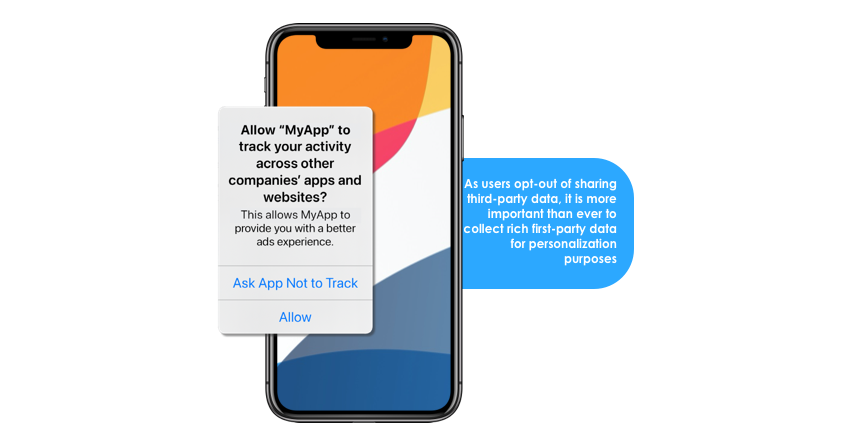Mobile is more important than ever before. It is the most important channel for consumers, and provides a direct-to-consumer connection for brands. And it’s not hard to see why—88% of consumers’ time on mobile (about 4 hours a day) is spent in mobile apps.
Meanwhile, as we learn to live with the Covid-19 pandemic, the world is turning to mobile at an ever increasing rate. According to new data from app store intelligence firm App Annie, mobile app usage grew 40% year-over-year in the second quarter of 2020, consumer spending in apps hit a record high of $27 billion in the second quarter, and app downloads reached a high of nearly 35 billion.
In short: mobile matters. But it matters as part of a larger world, and specifically a broader marketing landscape. Never before has it been so important to deliver integrated, consistent experiences across every channel, to share data across those channels, and to deliver the right experience, in the right place, at the right time.
Getting this right is a key challenge for any consumer-facing business.
Changing Privacy Laws Mean Trouble for ‘old-school’ Digital Marketing
As mobile, and the mobile app, goes from strength to strength, changing privacy policies are reducing the effectiveness of some other marketing channels. In some cases, they have the potential to kill them off entirely.
To illustrate this, let’s look at two announcements made at Apple’s Worldwide Developer Conference in June 2021.
First, the introduction of Mail Privacy Protection (MPP). In Apple’s own words, MPP “prevents senders from knowing when they (recipients) open an email”. By extension, this means that for Apple Mail users (46% of all email opens) the open rate as a meaningful metric is now dead, and in many cases orchestration engines dependent on checking the read status of email are also compromised.
Second, the ongoing squeeze around third-party tracking resulted in the announcement of the App Privacy Report (APP). In simple terms, this shows users which apps are accessing what data, and which third parties they might be sharing that data with. APP can be seen as an extension of App Tracking Transparency (ATT). The latter enabled users to simply say ‘no’ to any app collecting the user’s Identification for Advertisers (IDFA) data (as you might expect, most did). The former now allows those same users to check precisely how those apps with permission are behaving. And will probably lead to an increase in already high opt-out rates.

So much for the detail. What this means is straightforward enough: third-party data as a means of optimizing user experience and personalizing advertising is on its last legs.
In that context, consumer marketers need to get back to basics. Learn from the user behaviors that you collect first-hand. And communicate directly to your customers and prospects in channels that you control and can measure. In most cases: that means mobile.
Mobile: Where the Customer Is
At this point, let’s summarize before suggesting a way forward:
- Mobile is more popular than ever before.
- Mobile interactions are becoming the default in the ‘contactless world’.
- Many alternative means of collecting data and talking to consumers are rapidly being compromised by a new (and justified) focus on privacy.
So in the spirit of ‘being where the customer is’, it is surely time to double-down on native mobile user experience, collection of first-party data from mobile usage, and integration of a mobile element into cross-channel marketing campaigns.
This is the approach that we advocate and enable at Swrve.
The businesses that do this, that learn from mobile behavior, and that deliver great mobile experiences, will be positioned to win. They will successfully drive improved engagement, better customer satisfaction, greater loyalty, and ultimately more revenues. And the good news is, it is possible to do all of this today.
What Great Mobile Experience Looks Like
Most of us, as consumers ourselves, recognize great mobile experience when we see it. We can certainly spot the reverse.
Great experiences feel relevant, personal, helpful. We want to return to them. In contrast, we avoid poor experiences. As customers, we never return. And that is why it is so important to get this right. The following four principles will help.
Great mobile experience:
- Is built on true understanding, and lots of data. Before speaking, great communicators listen. The same is true when it comes to marketing. Make sure you have the tools in place to pick up every mobile signal your customer is sending you, and then share it with whoever, or whatever, needs to know. Like Salesforce Marketing Cloud, for instance. That data could relate to app usage, individual interactions (or their absence) both within and outside the app, location and location history—in fact almost anything you can collect. The goal is the sort of detailed knowledge that enables great, personal mobile interactions in the moment.
- Delivers deep, native interactions. Great marketing on mobile is not just old-fashioned text push and SMS. Whilst these channels have their place, they are not enough. Instead, aim to customize and optimize in-app messages and rich push notifications that look and feel like the native mobile experiences that they are. Go beyond text to incorporate images, video—even interactive multi-screen surveys and interactions.
- Uses A/B testing to optimize ‘embedded experiences’. To ensure that our customers and prospects get the most from mobile, we need to adapt experiences, and test competing variants, to ensure we are always providing the best experience possible. With the ability to create and deploy embedded content (essentially elements of the app served dynamically without any new updates to the app required), it is now possible to customize and optimize the entire in-app journey.
- Is integrated with other channels. As above, what we learn on mobile can and should influence how we interact in other channels such as email, retargeting, social and even direct mail. But just as importantly, mobile is just part of integrated, orchestrated campaigns and experiences that incorporate many or all of these channels. Mobile matters—but it works best as part of a bigger picture.

What each of the above use cases shows is how critical mobile is to integrated, cross-channel marketing campaigns. Both as a source of data and as a channel for communication in a variety of formats.
And of course, these examples are merely the tip of the iceberg. The ongoing rise of mobile, and indeed of apps in channels beyond mobile such as SmartTV, means that mobile is no longer an option or a nice-to-have. There are thousands of ways in which mobile can add value and help drive loyalty, retention, engagement, and revenue for businesses of all types.
Meaningful, native mobile experience must be part of the marketing mix.
Deploy Advanced Mobile Capabilities in Salesforce Marketing Cloud with Swrve
To learn more, read our latest eBook: Deploy Advanced Mobile Capabilities in Salesforce Marketing Cloud with Swrve to see how Swrve adds mobile-first touches and data to any omni-channel campaign in Salesforce Marketing Cloud, and learn key use cases and strategies that our customers use to increase engagement and drive revenues.








